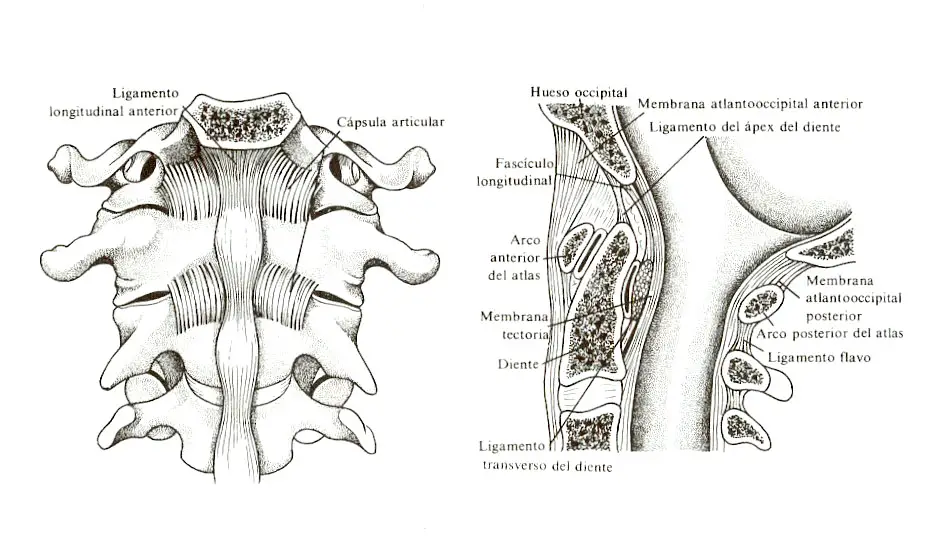The joints of the spine allow the unión between the bodies of the véadjacent vertebrae and the joints between adjacent vertebral arches.
There are two types of joints in the neck that receive special attention.ón because they are different from other joints: the atlantooccipitals and atlantoaxials in the regionón cervical superior.
These joints are located between the first two vécervical vertebrae and the cráneo, allow a greater degree of movement than in the rest of the spine.
The Vévertebrae spaghettién articulate with the ribs and hip bones.
Index
Atlantooccipital joints: Join the head and the atlas
They are synovial joints located between the cóoccipital indiles and superior articular surfaces of the lateral masses of the atlas.
We have two atlantooccipital joints, that allow to seat with the head (up and down movement).
Held in place by anterior and posterior atlanto-occipital membranes, that help prevent excessive movement of the joints.
Atlantoaxial joints: Join the atlas and axis
The three atlantoaxial joints are alsoén synovial joints.
One lies between the tooth (odontoid process) of the axis (second vértebra cervical) and the anterior arch of the atlas (primera vértebra cervical), and the other two are found between the lateral masses of the first vécervical rtebra and the upper facet joints of the second vértebra cervical.
The next four ligaments stabilize these joints:
- Apical ligament: Connect the tooth (odontoid process) to the foramen magnum of the occipital bone
- alar ligaments: Connect the tooth (odontoid process) at máLateral margins of foramen magnum
- Cruciform or cruciform ligament: Surround the tooth (odontoid process) to the anterior arch of the atlas and the body of the axis to the foramen magnum of the occipital bone
- stucco: It starts in the cráneo and becomes the posterior longitudinal ligament

Intervertebral joints: They unite to other vévertebrae between sí.
They are the ones that connect the véadjacent vertebrae, include both synovial joints, as cartilaginous.
Synovial Intervertebral Joints: They lie between the superior and inferior facets of the adjacent vertebral arches., and are supported by the following ligaments:
- The interspinous ligament extends between the apóspiny physis.
- The supraspinatus ligament connect the tips of the appóspinous physises and forms the strong nuchal ligament which passes behindás of the cervical spine.
- Intertransverse ligaments connect the apóadjacent transverse physises, and the yellow ligament connects the lámines of the véadjacent vertebrae.
Cartilaginous intervertebral joints: They are fibrocartilaginous joints forms between adjacent vertebral bodies with the fibrocartilaginous intervertebral discs lying between the bodies.
Each disc is made up of a jelly-like mass, The núcleo pulpy, what isá surrounded by annulus fibrosus (which is composed of fibrous layers máit's hard)
The anterior and posterior longitudinal ligaments run along the anterior and posterior surfaces of the vertebral bodies from the cráneo to sacrum. These help stabilize the spine.

Sacrum joints
The sacrum articulates with the hip bones to form the sacroil joints.íacas. The superior surface of the sacrum has two superior facets which articulate with the apóinferior articular physis of fifth vértebra lumbar.
It is formed between the coccyx and the sacrum. It has an intervertebral disc and is stabilized by sacrococcal ligaments.ígeos.
7 thoughts on “Joints”
Comments are closed.